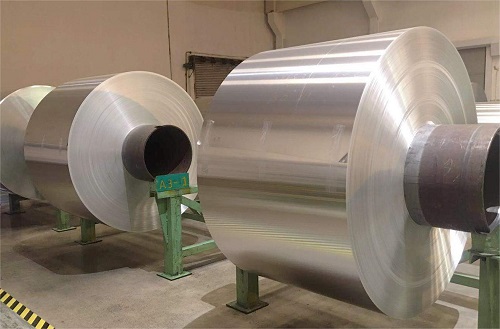What is 1145 aluminum foil alloy?
1145 aluminum foil is one of the 1000 series aluminum alloys. Aluminum alloy 1145 has a minimum aluminum content of 99.45%. Aluminum foil 1145 and aluminum foil 1235 are similar to 1235 in performance and have almost the same chemical properties.
 1145 aluminum foil roll
1145 aluminum foil rollWhat is the composition of aluminum foil 1145?
1145 aluminum alloy elements and content(%)
| Alloy | Al | Cu | Fe/Si | Mg | Mn | Ti | Zn | Cr | Others |
| 1145 | 99.45 | 0.05 | 0.55 | 0.05 | 0.05 | 0.03 | 0.05 | / | 0.05 |
Similarities between 1145 aluminum foil and 1235
Aluminum foil 1145 has almost the same chemical and physical properties as its sister alloy 1235. Occasionally, certain production lots may be dual certified for both 1145 and 1235 alloys. Like 1100 alloy, 1145 and 1235 are both considered commercially pure alloys and have excellent formability. Due to the higher aluminum content, 1145 alloy is becoming rarer in the market as many people find that 1235 alloy can sometimes be used as a replacement for 1145 aluminum foil alloy.
1145 aluminum foil performance advantages
1145 Aluminum Foil is a high-purity aluminum alloy with many performance advantages, especially for applications requiring good electrical and thermal properties.
Superior electrical conductivity: 1145 aluminum foil has excellent electrical conductivity and is ideal for the manufacture of electrical wires, cables, capacitors, and other electronic components.
Excellent thermal conductivity: 1145 aluminum foil has good thermal conductivity and can be used in heat dissipation applications, such as heat sinks and heat exchangers, and its high thermal conductivity helps to quickly dissipate heat.
High purity: 1145 aluminum foil is a high-purity alloy, usually with an aluminum content of more than 99.45%.
Good corrosion resistance: 1145 aluminum foil has good corrosion resistance. This makes it perform well in some environments where corrosion resistance is required.
Easy to shape: 1145 aluminum foil has good plasticity and formability, and can be made into various shapes through different processing techniques to meet the needs of different applications.
Lightweight: Aluminum is a lightweight metal, and 1145 aluminum foil has a lower density than other materials.
Environmental protection: Aluminum is a recyclable material, and 1145 aluminum foil can be recycled and reused, which helps to reduce resource consumption and environmental impact.
Processing performance: 1145 aluminum foil has good processing performance, and can be processed by cutting, stamping, bending and welding to meet different production needs.
1145 aluminum foil mechanical properties parameters
The mechanical properties of 1145 aluminum foil can vary depending on factors such as temper (heat treatment) and manufacturing processes. However, since 1145 is often used for its electrical and thermal properties rather than its mechanical strength, it typically does not have particularly high tensile strength or hardness compared to other aluminum alloys that are engineered for strength. Here are some general mechanical properties parameters for 1145 aluminum foil:
Tensile Strength: The tensile strength of 1145 aluminum foil is relatively low compared to other aluminum alloys. It typically ranges from around 70 MPa to 140 MPa (10,000 psi to 20,000 psi), depending on the specific temper.
Elongation: Elongation refers to the ability of the material to deform before breaking. 1145 aluminum foil can have elongation values ranging from about 1% to 5%, again depending on the temper.
Yield Strength: The yield strength of 1145 aluminum foil is typically not specified as prominently as it is for higher-strength alloys. This is because 1145 is not generally used for applications where yield strength is a critical factor.
Hardness: The hardness of 1145 aluminum foil is relatively low due to its high purity and lack of significant alloying elements that contribute to hardness. Hardness values can range from around 20 to 40 on the Brinell hardness scale (HB), depending on the temper.
Modulus of Elasticity: The modulus of elasticity, also known as Young’s modulus, is a measure of a material’s stiffness. The modulus of elasticity for 1145 aluminum foil is around 70 GPa (10.1 million psi).
Fatigue Strength: 1145 aluminum foil is not typically specified for applications involving cyclic loading or fatigue, as its strength properties are relatively low compared to alloys designed for fatigue resistance.
